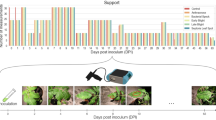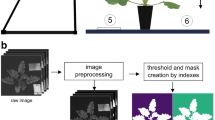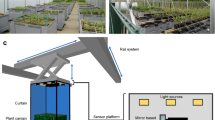Abstract
Researchers have shown increasing interest in hyperspectral imaging for detecting potato late blight disease (Phytophthora infestans). Because it is difficult to get accurate spectral signatures of disease development in field conditions, especially at early disease stages, previous works focused on laboratory measurements under controlled conditions. However, the extrapolation of results from a laboratory to a field setting has proven difficult. The current work evaluates the use of laboratory hyperspectral data to train an in-field detection model for potato late blight. A hyperspectral training library was constructed from six detached leaf trays, containing 8585 spectra labelled into a healthy class and five progressive stages of disease development. After smoothing and normalisation, a logistic regression model was trained on 70.0% of this data, with 30.0% reserved for validation. Twelve hyperspectral images taken in field conditions were then classified, for two potato cultivars (susceptible and resistant to late blight), at high and low disease pressure. The classification accuracy of laboratory data was 94.1%, which was not sufficient to detect field symptoms, using infield collected dataset. When spectra pre-processing was changed by including first derivation and adopting a new normalisation strategy, a new model resulted in a lower classification accuracy of 80.8%, validated on labelled laboratory spectra, but was able to detect symptoms in field conditions. The correlation between visual disease scoring and the classification result of the field disease model yielded an R2 value of 0.985. It could be concluded that it was possible to train a model on laboratory data for in-field disease detection.










Similar content being viewed by others
Data availability
The datasets and code generated during and/or analysed during the current study are available from the corresponding author on reasonable request.
Abbreviations
- FDR:
-
False discovery rate
- FNR:
-
False negative rate
- FPR:
-
False positive rate
- NDVI:
-
Normalized difference vegetation index
- NIR:
-
Near-infrared
- NPV:
-
Negative predictive value
- PCA:
-
Interprovinciaal proefcentrum voor de aardappelteelt
- PPV:
-
Positive prediction value
- TNR:
-
True negative rate
- TPR:
-
True positive rate
- VIS:
-
Visible
References
Agrios, G. (2005). Plant Pathology (5th ed.). Academic Press. https://doi.org/10.1016/j.plantsci.2005.02.019
Akino, S., Takemoto, D., & Hosaka, K. (2014). Phytophthora infestans: A review of past and current studies on potato late blight. Journal of General Plant Pathology, 80(1), 24–37. https://doi.org/10.1007/s10327-013-0495-x
Alsuwaidi, A., Grieve, B., & Yin, H. (2018). Feature-ensemble-based novelty detection for analyzing plant hyperspectral datasets. IEEE Journal of Selected Topics in Applied Earth Observations and Remote Sensing, 11(4), 1041–1055. https://doi.org/10.1109/JSTARS.2017.2788426
Appeltans, S., Guerrero, A., Nawar, S., Pieters, J., & Mouazen, A. M. (2020). Practical recommendations for hyperspectral and thermal proximal disease sensing in potato and. Remote Sensing, 12(1939), 1–19. https://doi.org/10.3390/rs12121939
Appeltans, S., Pieters, J. G., & Mouazen, A. M. (2021). Detection of leek white tip disease under field conditions using hyperspectral proximal sensing and supervised machine learning. Computers and Electronics in Agriculture, 190, 106453. https://doi.org/10.1016/j.compag.2021.106453
Asner, G. P. (1998). Biophysical and biochemical sources of variability in canopy reflectance. Remote Sensing of Environment., 64(3), 234–253. https://doi.org/10.1016/S0034-4257(98)00014-5
Barbedo, J. G. A., Tibola, C. S., & Fernandes, J. M. C. (2015). Detecting Fusarium head blight in wheat kernels using hyperspectral imaging. Biosystems Engineering, 131, 65–76. https://doi.org/10.1016/j.biosystemseng.2015.01.003
Behmann, J., Mahlein, A. K., Rumpf, T., Römer, C., & Plümer, L. (2015). A review of advanced machine learning methods for the detection of biotic stress in precision crop protection. Precision Agriculture, 16(3), 239–260. https://doi.org/10.1007/s11119-014-9372-7
Bohnenkamp, D., Behmann, J., & Mahlein, A. K. (2019). In-field detection of yellow rust in wheat on the ground canopy and UAV scale. Remote Sensing. https://doi.org/10.3390/rs11212495
Bousquet, L., Lachérade, S., Jacquemoud, S., & Moya, I. (2005). Leaf BRDF measurements and model for specular and diffuse components differentiation. Remote Sensing of Environment, 98(2–3), 201–211. https://doi.org/10.1016/j.rse.2005.07.005
Coops, N. C., Smith, M. L., Martin, M. E., & Ollinger, S. V. (2003). Prediction of eucalypt foliage nitrogen content from satellite-derived hyperspectral data. IEEE Transactions on Geoscience and Remote Sensing, 41(6), 1338–1346. https://doi.org/10.1109/TGRS.2003.813135
EPPO. (2021). EPPO global database. Retrieved from https://gd.eppo.int.
Fernández, C. I., Leblon, B., Haddadi, A., Wang, J., & Wang, K. (2020a). Potato late blight detection at the leaf and canopy level using hyperspectral data. Canadian Journal of Remote Sensing, 46(4), 390–413. https://doi.org/10.1080/07038992.2020.1769471
Fernández, C. I., Leblon, B., Haddadi, A., Wang, K., & Wang, J. (2020b). Potato late blight detection at the leaf and canopy levels based in the red and red-edge spectral regions. Remote Sensing, 12(8), 1292. https://doi.org/10.3390/RS12081292
Franceschini, M. H. D., Bartholomeus, H., van Apeldoorn, D. F., Suomalainen, J., & Kooistra, L. (2019). Feasibility of unmanned aerial vehicle optical imagery for early detection and severity assessment of late blight in potato. Remote Sensing, 11(3), 224. https://doi.org/10.3390/rs11030224
Fry, W. (2008). Phytophthora infestans: The plant (and R gene) destroyer. Molecular Plant Pathology, 9(3), 385–402. https://doi.org/10.1111/j.1364-3703.2007.00465.x
Geiger, F., Bengtsson, J., Berendse, F., Weisser, W. W., Emmerson, M., Morales, M. B., et al. (2010). Persistent negative effects of pesticides on biodiversity and biological control potential on European farmland. Basic and Applied Ecology, 11(2), 97–105. https://doi.org/10.1016/j.baae.2009.12.001
Gold, K. M., Townsend, P. A., Chlus, A., Herrmann, I., Couture, J. J., Larson, E. R., et al. (2020a). Hyperspectral measurements enable pre-symptomatic detection and differentiation of contrasting physiological effects of late blight and early blight in potato. Remote Sensing. https://doi.org/10.3390/rs12020286
Gold, K. M., Townsend, P. A., Herrmann, I., & Gevens, A. J. (2020b). Investigating potato late blight physiological differences across potato cultivars with spectroscopy and machine learning. Plant Science, 295, 110316. https://doi.org/10.1016/j.plantsci.2019.110316
Haverkort, A. J., Boonekamp, P. M., Hutten, R., Jacobsen, E., Lotz, L. A. P., Kessel, G. J. T., et al. (2008). Societal costs of late blight in potato and prospects of durable resistance through cisgenic modification. Potato Research, 51(1), 47–57. https://doi.org/10.1007/s11540-008-9089-y
Karki, H. S., & Halterman, D. A. (2021). Phytophthora infestans (late blight) infection assay in a detached leaf of potato. Bio-Protocol, 11(4), e3926–e3926.
Li, L., Zhang, Q., & Huang, D. (2014). A review of imaging techniques for plant phenotyping. Sensors (switzerland), 14(11), 20078–20111. https://doi.org/10.3390/s141120078
Mahlein, A. K., Oerke, E. C., Steiner, U., & Dehne, H. W. (2012). Recent advances in sensing plant diseases for precision crop protection. European Journal of Plant Pathology, 133(1), 197–209. https://doi.org/10.1007/s10658-011-9878-z
Mahlein, A.-K., Kuska, M. T., Behmann, J., Polder, G., & Walter, A. (2018). Hyperspectral sensors and imaging technologies in phytopathology: State of the art. Annual Review of Phytopathology, 56(1), 535–558. https://doi.org/10.1146/annurev-phyto-080417-050100
Oberti, R., Marchi, M., Tirelli, P., Calcante, A., Iriti, M., & Borghese, A. N. (2014). Automatic detection of powdery mildew on grapevine leaves by image analysis: Optimal view-angle range to increase the sensitivity. Computers and Electronics in Agriculture, 104, 1–8. https://doi.org/10.1016/j.compag.2014.03.001
Pedregosa, F., Varoquaux, G., Gramfort, A., Michel, V., Thirion, B., Grisel, O., Blondel, M., Prettenhofer, P., Weiss, R., Dubourg, V., Vanderplas, J., Passos, A., Cournapeau, D., Brucher, M., Perrot, M., & Duchesnay, E. (2011). Scikit-learn: Machine learning in Python. The Journal of Machine Learning Research, 12, 2825–2830.
Pinter, P. J., Jackson, R. D., Elaine Ezra, C., & Gausman, H. W. (1985). Sun-angle and canopy-architecture effects on the spectral reflectance of six wheat cultivars. International Journal of Remote Sensing, 6(12), 1813–1825. https://doi.org/10.1080/01431168508948330
Ray, S. S., Jain, N., Arora, R. K., Chavan, S., & Panigrahy, S. (2011). Utility of hyperspectral data for potato late blight disease detection. Journal of the Indian Society of Remote Sensing, 39(2), 161–169. https://doi.org/10.1007/s12524-011-0094-2
Rumpf, T., Mahlein, A. K., Steiner, U., Oerke, E. C., Dehne, H. W., & Plümer, L. (2010). Early detection and classification of plant diseases with support vector machines based on hyperspectral reflectance. Computers and Electronics in Agriculture, 74(1), 91–99. https://doi.org/10.1016/j.compag.2010.06.009
Sugiura, R., Tsuda, S., Tamiya, S., Itoh, A., Nishiwaki, K., Murakami, N., et al. (2016). Field phenotyping system for the assessment of potato late blight resistance using RGB imagery from an unmanned aerial vehicle. Biosystems Engineering, 148, 1–10. https://doi.org/10.1016/j.biosystemseng.2016.04.010
Thenkabail, P. S., & Lyon, J. G. (Eds.). (2016). Hyperspectral remote sensing of vegetation. Boca Ratton, FL, USA: CRC Press.
Thomas, S., Kuska, M. T., Bohnenkamp, D., Brugger, A., Alisaac, E., Wahabzada, M., et al. (2018). Benefits of hyperspectral imaging for plant disease detection and plant protection: A technical perspective. Journal of Plant Diseases and Protection, 125(1), 5–20. https://doi.org/10.1007/s41348-017-0124-6
Wahabzada, M., Mahlein, A. K., Bauckhage, C., Steiner, U., Oerke, E. C., & Kersting, K. (2015). Metro maps of plant disease dynamics-automated mining of differences using hyperspectral images. PLoS ONE. https://doi.org/10.1371/journal.pone.0116902
Whetton, R. L., Waine, T. W., & Mouazen, A. M. (2017). Optimising configuration of a hyperspectral imager for on-line field measurement of wheat canopy. Biosystems Engineering, 155, 84–95. https://doi.org/10.1016/j.biosystemseng.2016.12.006
Whetton, R. L., Hassall, K. L., Waine, T. W., & Mouazen, A. M. (2018a). Hyperspectral measurements of yellow rust and fusarium head blight in cereal crops: Part 1: Laboratory study. Biosystems Engineering, 166, 101–115. https://doi.org/10.1016/j.biosystemseng.2017.11.008
Whetton, R. L., Waine, T. W., & Mouazen, A. M. (2018b). Hyperspectral measurements of yellow rust and fusarium head blight in cereal crops: Part 2: On-line field measurement. Biosystems Engineering, 167, 144–158. https://doi.org/10.1016/j.biosystemseng.2018.01.004
Zhang, J., Huang, Y., Pu, R., Gonzalez-Moreno, P., Yuan, L., Wu, K., et al. (2019). Monitoring plant diseases and pests through remote sensing technology: A review. Computers and Electronics in Agriculture, 165, 104943. https://doi.org/10.1016/j.compag.2019.104943
Acknowledgements
A big thank you to the technicians at PCA (Jenny Heuvick, Bart De Vriese and Pascal Dupont) for their help during field work and disease scoring of the trial fields at PCA. We are also grateful to the people at the Bottelare experimental farm, especially Kevin Dewitte, for helping with the collection of laboratory data.
Funding
Authors acknowledge the financial support received from the Research Foundation—Flanders (FWO) for Odysseus I SiTeMan Project (Nr. G0F9216N).
Author information
Authors and Affiliations
Corresponding author
Ethics declarations
Conflict of interest
The authors declare no conflict of interest.
Additional information
Publisher's Note
Springer Nature remains neutral with regard to jurisdictional claims in published maps and institutional affiliations.
Rights and permissions
About this article
Cite this article
Appeltans, S., Pieters, J.G. & Mouazen, A.M. Potential of laboratory hyperspectral data for in-field detection of Phytophthora infestans on potato. Precision Agric 23, 876–893 (2022). https://doi.org/10.1007/s11119-021-09865-0
Accepted:
Published:
Issue Date:
DOI: https://doi.org/10.1007/s11119-021-09865-0




